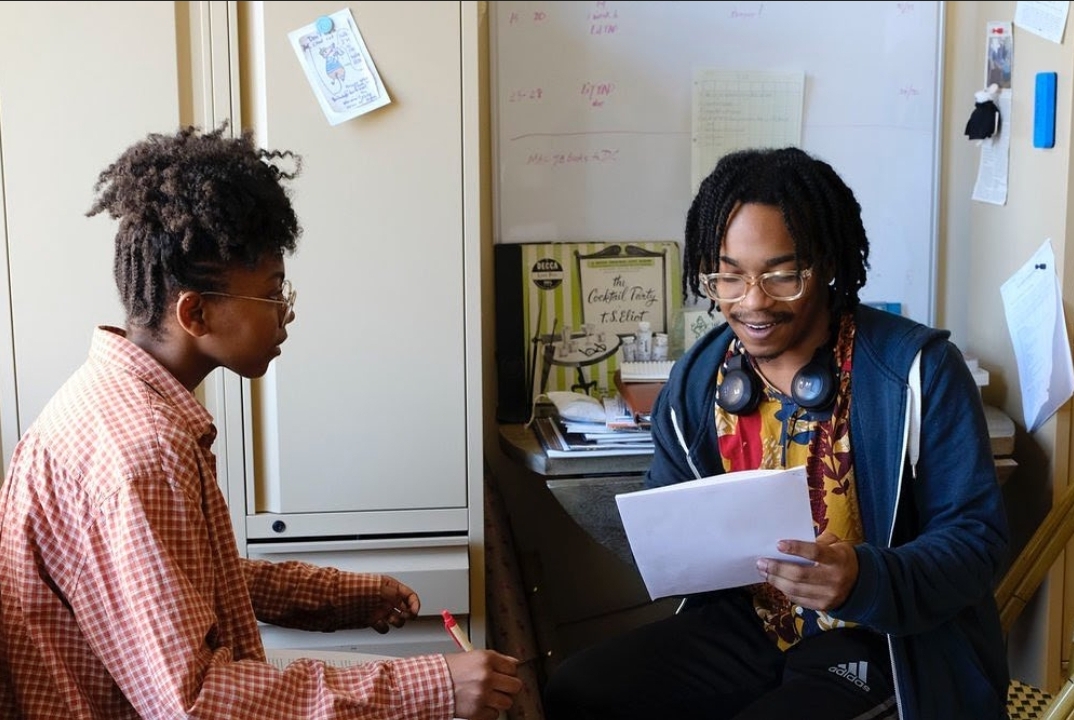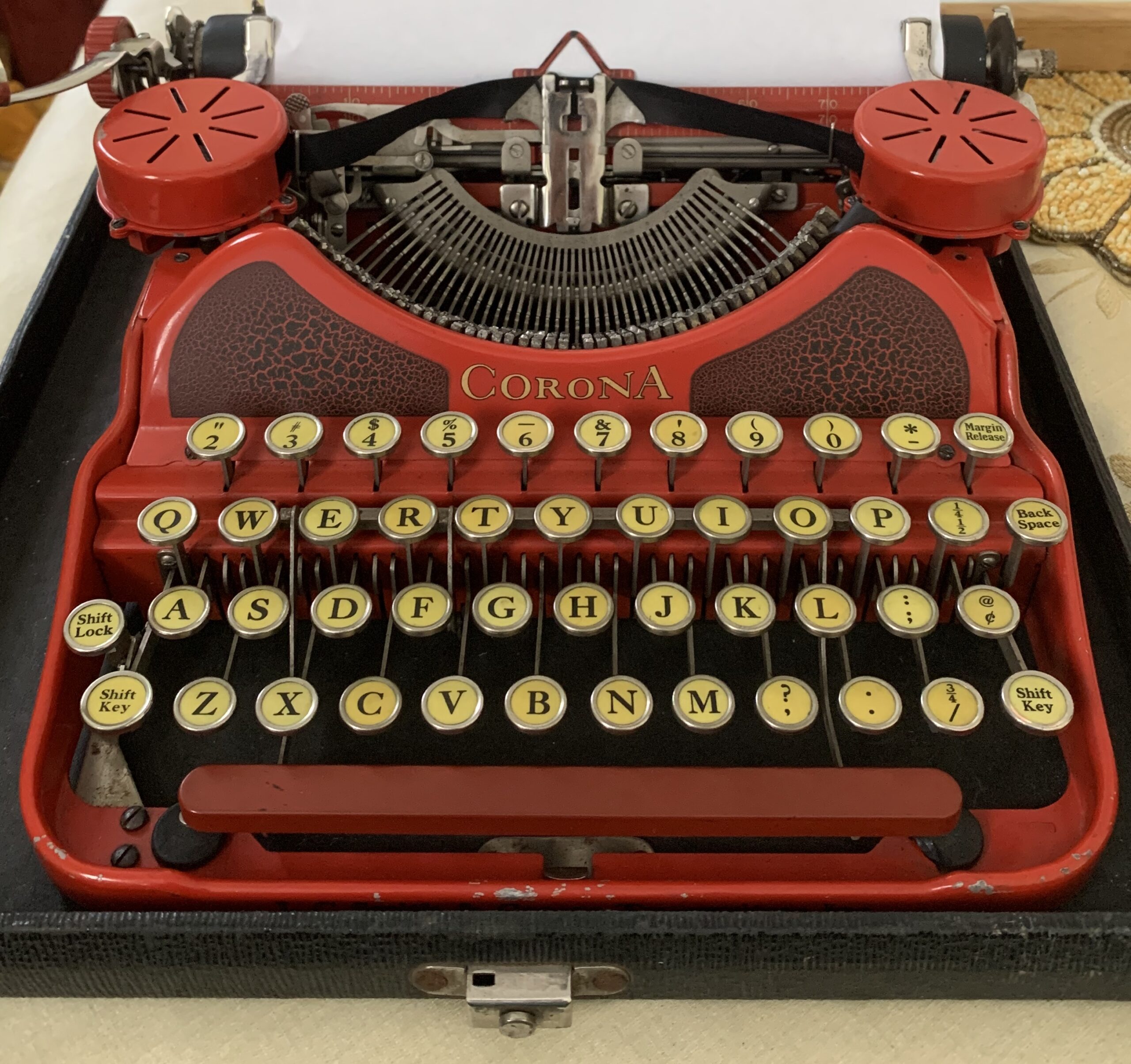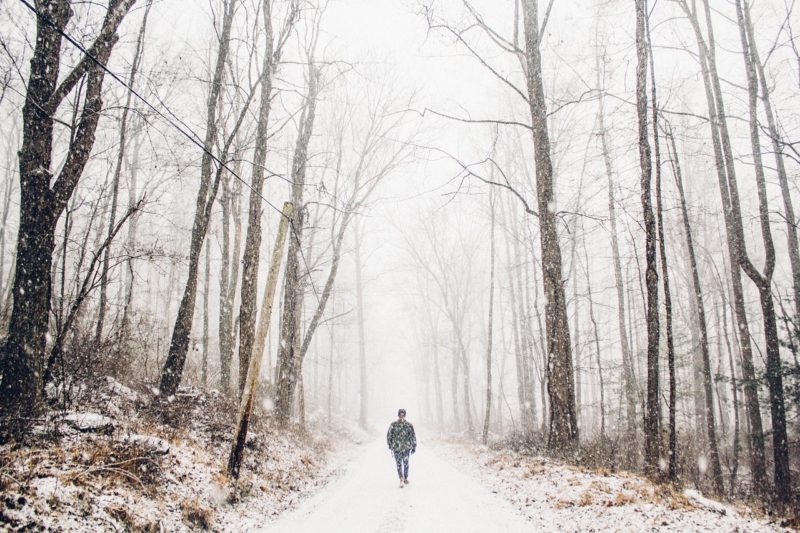Poet and teaching artist Trace DePass riffs on the contrapuntal as a poetic form and a way of looking at the world.
If there is any poetic form I live in daily, it is the contrapuntal. The contrapuntal form in poetry is made up of two or more columns which can be read vertically & also horizontally across, in multiple iterations or combinations. It can be as simple as an intuitive conversation between two voices. I see the form in how my students create dialogue in the white blank zoom chat &, before that, in classrooms in Queens or in The Bronx.
In the teaching of this form (like any other), both in-person and virtual classrooms during the pandemic, I suggest we choose affirmation that we live, for a moment, in the Yes, and… logic of the theater game where participants elaborate on what another participant has said by agreeing yes, then elaborating using the word and. It’s one way to keep a conversation going. If you saw the aforementioned ongoing dialogue on paper, and, hypothetically took a few yes’s out, the dialogue could be read as one long sentence, made non-linear yet still coherent, like a contrapuntal poem.
The first time I wrote one I didn’t even realize I had written a contrapuntal. When I was in high school, I was so excited back at the old Urban Word NYC office on 27th street, I showed Jon Sands my 2-column poem called Silence. The year was 2014, Jon was & still is someone a lot of my friends have come to know as both a friend & a mentor. He let me know poets were already doing what I was doing with that poem. He also let me borrow leadbelly by Tyehimba Jess, which affirmed me & changed my life (as poetry often does). Writing the poem as I was in high school, I just felt compelled to split lines in a way that gave me more agency in reading it out loud. Is this a thing? I asked myself, assuming I was experimenting. Following year, I would go on to win a National Gold Medal from Scholastic for my portfolio, Black Boyhood, with Silence being one of only 4 poems in it:
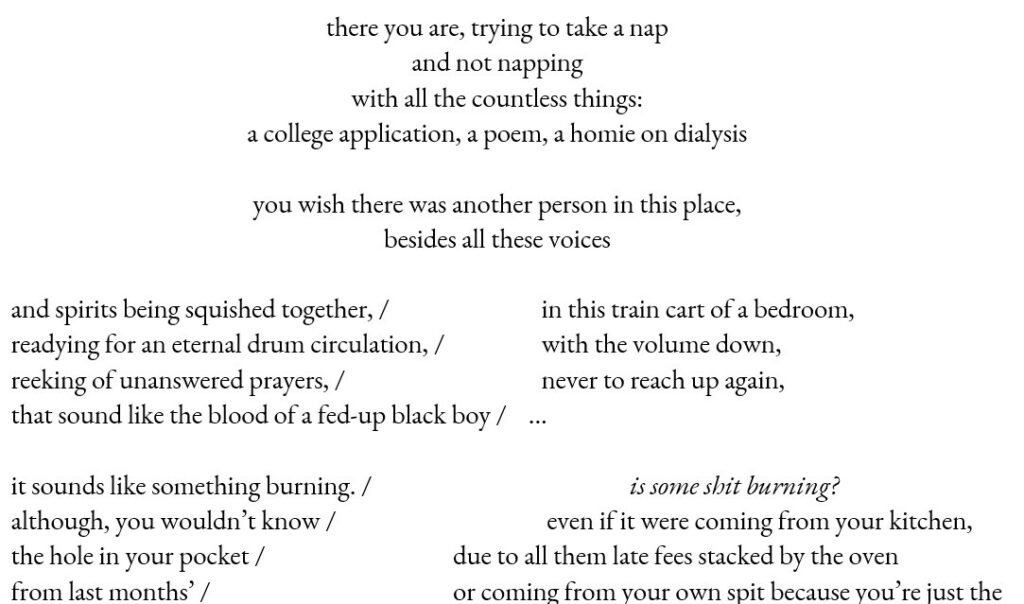
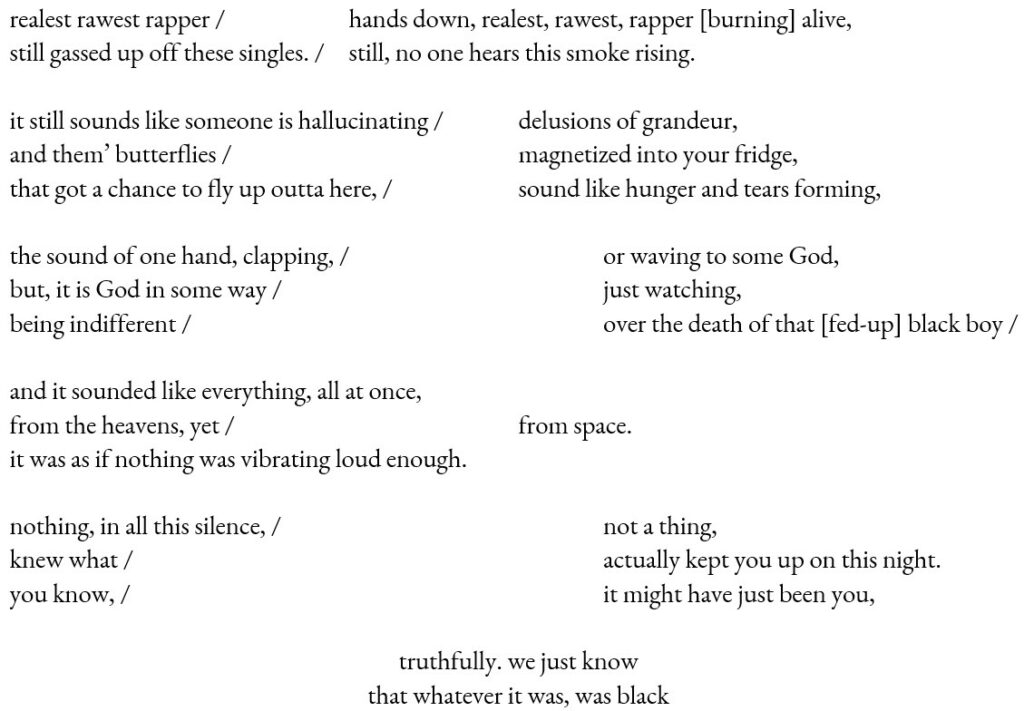
This poem, being a metaphysical conceit (or extended metaphor) of silence through the lens of being a black high school senior in my grandmother’s home during the murders of Mike Brown, Eric Garner, & the protests of countless others, it felt like the lines, bars or sentences about my condition could connect & reify each other endlessly. Adopted by my grandmother then having gone to custody court as a child & hearing my mother tell me I would have a better life with my grandmother, I was forced by court to pick a path where I was ultimately still in a black & poor childhood regardless of the news. Poems (not unlike my own body) with multiple paths gave me the ultimate sense of reclaimed agency. I could reimagine everything that led up to the present as if causes or effects were freeze frame moments that I could reframe & rearrange. I was able to publish this poem again in 2018 within my debut book of poems, Self-portrait as the space between us.
The poem which also shares the title of my whole debut also breaks into a 3-column contrapuntal, processing public spaces we share wherein assailants & perpetrators of violence also take up space:
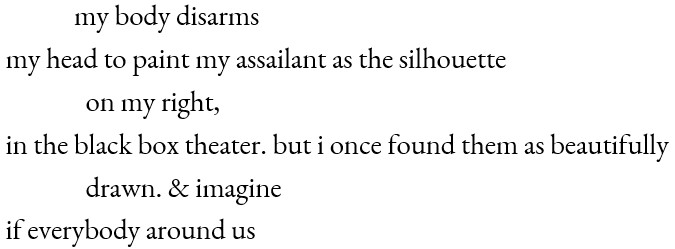
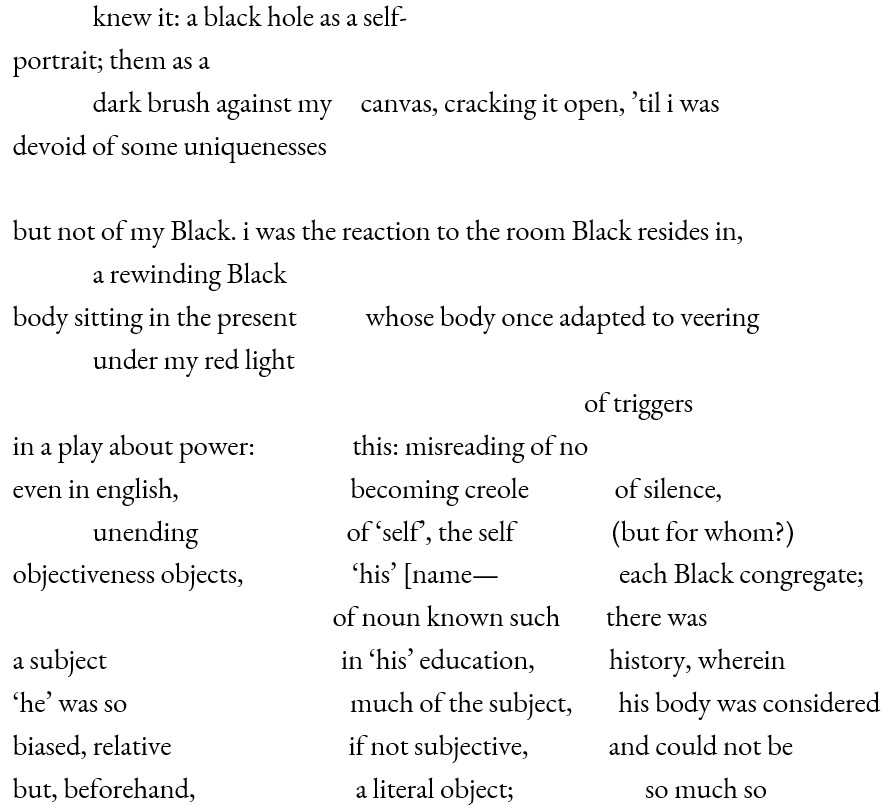
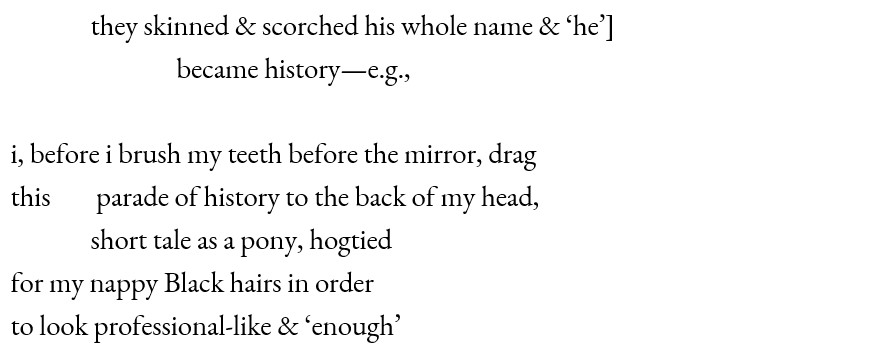
The 3 columns in this poem were originally one prose block of text with the exact same words. The poem concludes or convenes at the same ‘lobby’, ultimately with me choosing to keep it ‘together’ in a room. This word ‘wherein’ gave space for me to further name institutional harm while also giving me the agency to tell the story in the sequence that makes me feel the most heard, or safe, or free.
The contrapuntal poems in the book come together telling non-linear versions of the same narrative which also echo history, particularly that of the sexual violence endured by slaves & those sharing this trauma by sharing the inherited genetic make up of their African ancestors. ‘Of’ is another word concretizing other nouns here, like ‘creole’, which could also be said for ‘if’ within the phrase ‘if not subjective’ which negotiates the phrases successively or independently ‘much of the subject,’ ‘his body was considered’ & ‘biased, relative’. I have strategies therein for ways of being emotionally, historically & intellectually honest while having a sort of structural integrity by way of the contrapuntal form, perhaps for now I could name them elevator tactics or metaphorical ‘counterweights’ to achieve ‘counterbalance’ (but this is not a foolproof formula), which I’ll show. While considering prompts I write & facilitate in classrooms now via Zoom, I turned the elevator into an acronym for writing or revising the contrapuntal:
Elongate
Lateral
Ending
Variations
As
To
Orient
Readers
What Elevators, Catapults, & Contrapuntals Have in Common
Before we got into freestyling these contrapuntal poems as a group in a Queens 12th grade class, I asked each participant to list: 5 times you knew you were loved or knew you loved someone; then, list 5 times you knew you needed love. Teaching within the NYC Department of Education where the spirit, presence, & historical context of Black youth may feel institutionally scarce, I give a prompt to intentionally summon movement, identity, hope, joy, faith, or love, often simultaneously, in the classroom.
Since mine may be the only class centering self-love in their day that day, I give a prompt disguised as a participatory game of finish-the-sentence as a way of making the process of writing a contrapuntal feel welcoming & intuitive to those who might feel stuck at where to begin. I start with the unfinished clause, When I was younger I needed…. We each contribute a clause then pass it on to another poet with a transitional word like “and”, “if”, “when”, “while”, “then”, or even simply the word “I”. The resulting narratives overlap in space & time, declaring & defining our needs as individuals and as a community. The allusions in the community poem below, written Via Zoom in the fall semester, could very well read, despite the polyphony of young writers, as one speaker regarding a parent or loved one:
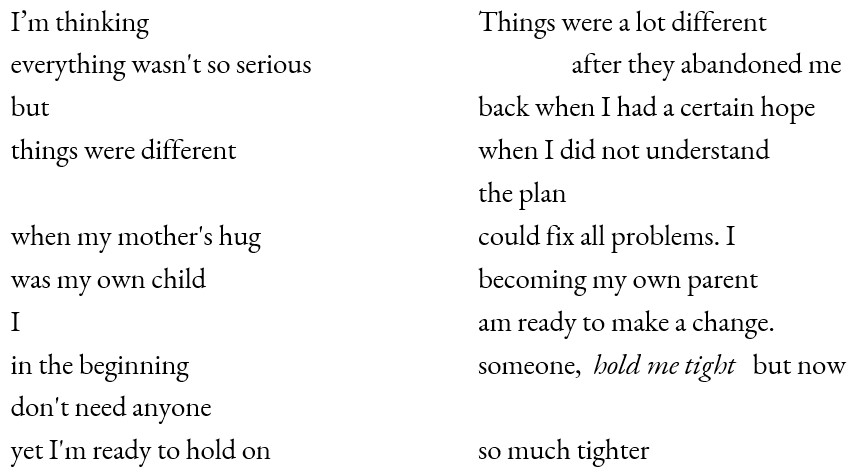
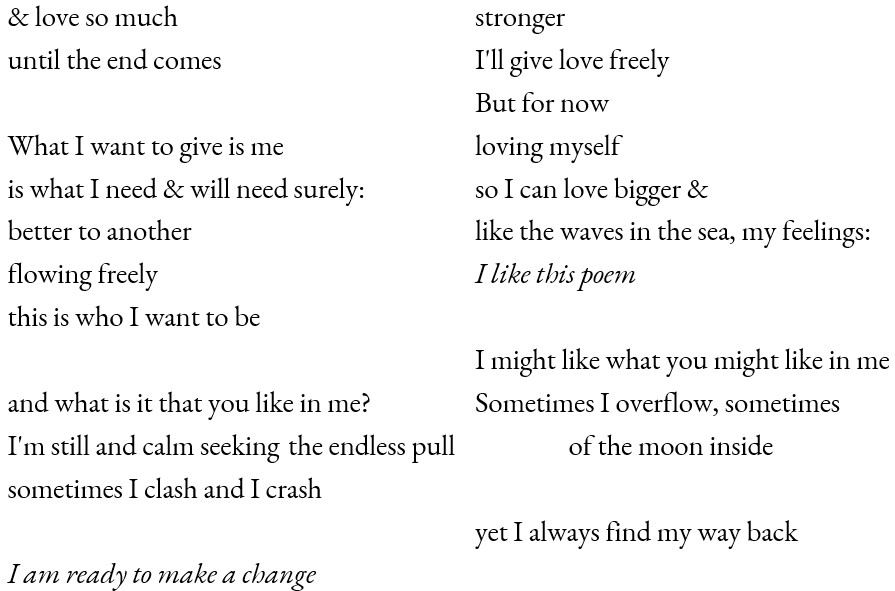
Regarding these community poems, we went with this strategy of writing so that each line contributed in the Zoom chat reads into multiple lines in the Zoom chat. When trying to draft a contrapuntal over a single session: rather than try and write 2 poems at once, which is how a contrapuntal poem might appear, students write in couplets or stanzas, then edit so the first line of every couplet (lines 1, 3, 5, 7, 9, etc.) connects to each other, then edit doing the same for the 2nd lines of every couplet (lines 2, 4, 6, 8, etc.), only to finally place the even numbers lines on the right side of the page. In theory, our lines are counterweights to a catapult, set so that each can be launched to multiple landings or endings: your independent clauses.
Syntactically, phrasing a question as a dependent clause acts like a counterweight in order to give a line (or, in real life, a body) lift! Two points of reference: a) of course, elevators or vehicles of accessibility, & b) tools of siege like catapults used to overthrow a castle. Both elevators and catapults feel present for me being Black & of Shinnecock tribal affiliation living in the city of NY built on stolen, sieged upon, land. Though I may not have a literal catapult nor truly own my home as a tenant, I have what I’ve built with my identity & community in order to sustain my personal peace treaty with the mirror. Both catapults & elevators use counterweights to achieve counterbalance: weight or force that balances or offsets another as when two objects of equal weight, power, or influence are acting in opposition to each other. The objects then are said to be in counterbalance.
Roundabout even-odd elevators in project buildings in NYC service every other floor or landing. What else can be said about the structure of elevators? How might traffic disseminate bodies to prevent too-long lines from forming? For every double-decker elevator, there is still a lobby which connects a community for exiting & entering. The elevator exists, for the sake of a metaphor echoing into other applicable contexts, in museums not unlike the project buildings. The elevator meets all ground-level at the lobby (often being lowered or raised into other lines carrying bodies) in conversation, wondering where we are all going or what there is to see. Flexibly refurbished, like homes in projects, an elevator opening to museum galleries of our own terms is another way I imagine writing in contrapuntal structures. Yes, but elevator for whom? To where? I feel there’s an elevator for our inner child to anywhere, to disrupt notions that sentiment should be exclusive from poetry craft conversations!
By the end of this Queens class, students were glad to be able to see a new side of each other, through being given the space to be vulnerable in our class. The exercise helps us affirm our narrative while also allowing us to heal in a way that is not restricted to linear thought. It gives the writer consistently new entry points & allows the reader to synthesize their own experience or possible parallels by being given multiple paths in the form.
Love has form & content —or— The contrapuntal as an anti-racist philosophy
How is it that you want to be loved? What exactly do you need in order to be comfortable telling or asking a companion for or about love? What did you want & what do you want now? How does this contrapuntal kind of game of inquiry & response, relate forms of poetry with forms of love? I might ask you, if you were writing a contrapuntal: is the poem non-linear? How can I move the speaker as if through an elevator, to give the speaker agency or access rather than through one absolute path? Like with writing a contrapuntal, I’m trying to show all its possible tools we can take with us elsewhere, like listening or organizing.
Workshopping on Valentine’s Day with a community of friends & peer writers in my Want, Consent & Contrapuntals class, Lonnie pens a piece on love which spans upwards of 4 bodies dispersed through time:
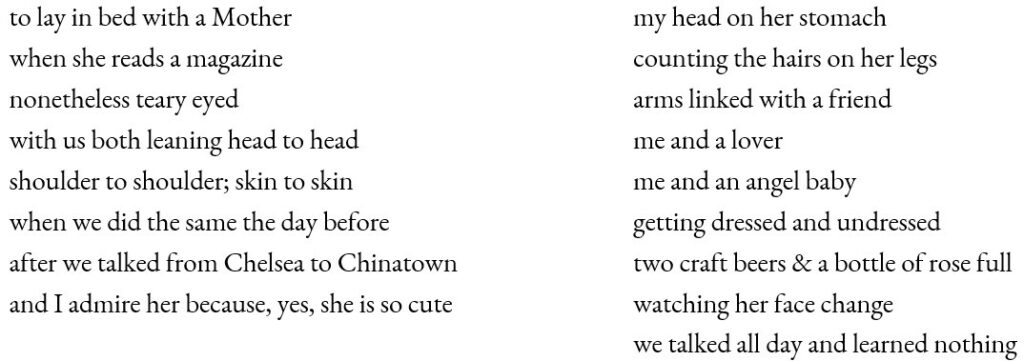
When having trouble editing, cut a line’s weight off & begin again: allow for more enjambment (line breaks) to find, surprise, & guide you & then lean into the logic once you feel each side parallels or compliments (also diverges) from the other. What we place as a line to be launched, whatever we make of the inertia of writing or living, we have agency to imagine, use & break down into amino acids or Legos to rebuild with time. The contrapuntal provides not an erasure of narratives but yields, if not sieges, against a fixed construct of time, which implies speaker(s) get to reset, reassemble, discover or divide to present new boundaries between findings. Plurality lives in the form, nearly forgiving or arresting readers, given its demand to be restated if not reread.
Maybe launching a ‘love prompt’ undermines the silence of patriarchal assumption! To start, your whole poem could be one side contextualizing the speaker’s other side; that, yes, and maybe a siege of lines trying to both find & hold a need, like to be cared far, through a poem; a siege on what it might mean to be ‘literary’.
“The insistence on literary writing is an apt starting place, for what is ‘literary’ code for? A lot of workshop leaders front like even they don’t know, appending a jokey ‘whatever that means’ in parentheticals. Because who wants to come out and say it? Literary means civilized, cultured, ‘classical’ writing. (There’s that word again! Evidence that English and creative writing share a mutual reinforcement of white supremacist infrastructure.) This is not your common creative expression; it’s not genre entertainment for the masses. Literary writing has noble merit, in the tradition of privileged white male figureheads. It’s infused with elevated purpose, grappling with complex truths and the profundity of the (privileged, white, male) human condition. ‘Literary,’ in sum, means gatekeeper.”
From The Anti-Racist Writing Workshop, by Felicia Rose Chavez
Affirmed yet challenged by Felicia Rose Chavez’s work, excerpted here from her book The Anti-Racist Writing Workshop, I am reminded of how the toolbox of poetic forms has always grounded me as a writer. I would go as far as to say that form continues to save my life. One task poets take on: to make language, community, or work a lot less racist, homophobic, ableist, or informed by another capitalist, white supremacist hierarchy. Writing this article presents a challenge: I can’t avoid sitting with all the emotional labor I am trying to do as a writer working with other young writers; in classroom after classroom I see how formal teaching of writing & reading fails to deliver emotional sustainability due to aforementioned racism, homophobia & ableism embedded in the department(s) of education, especially in NYC. All of this is very sobering for me.
Landing somewhere within a lineage of contrapuntal poems, I ask myself walking in the steps of poets who lived before me & poets who live today: How do I center those that have experienced shame or traumatic encounters within institutions of English, what is “Fine Art,” or any hierarchical banking system of education (as Paulo Friere might refer to it)? With young Black Americans put in the predicament of having to find if not buy access to their history, what resources do we have for linear narrative expression let alone challenging young people to craft grammatical fluidity from one line to one, two, or three lines beneath, adjacent, &/or across? How do I go further? Might there be a metaphor in how vehicles for accessibility (like the escalator or elevator) might inform other structures like poetry forms? I’m wondering! How can I alleviate the poet’s passenger speaker, the passenger poet?
Publishing experimentation I’m still processing myself might risk convention & trouble the line, troubling the mind, troubling the body further. With that being said, the latter of which is to say if my colloquialisms or meta-text fail as a teacher or as an artist, I am sorry I failed you. Just as any misfiring of my students is a reflection of me, failure is institutional if not communal & coexists within racialized socioeconomic context (if it exists at all). Failure cannot continue to define black writers or experimental young people. Still, I would not be here writing in form or writing about the process of trying to teach it, had it not been for me failing, flailing, or writing against english. Youth, my own & whom I work with, save me by existing. In a myriad of ways, regardless of sequential order or imposed constraints of linear time, I have no shame in telling whom I work with —

Now I turn to you, dear reader! Feel free to use any of the tools here to write or teach, where might a poet find lift, a contrapuntal! At any rate, thank you for reading all of this! Thank you for being the reader you are!
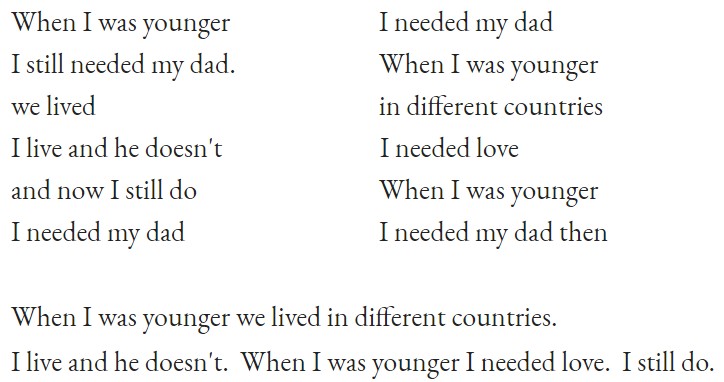
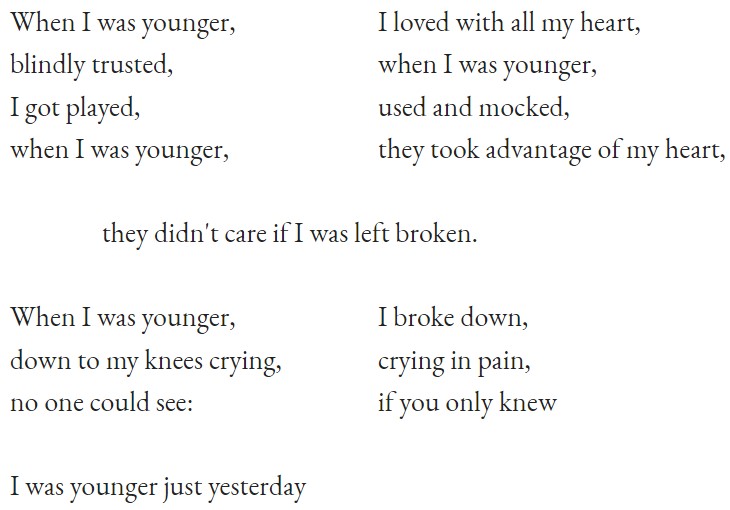
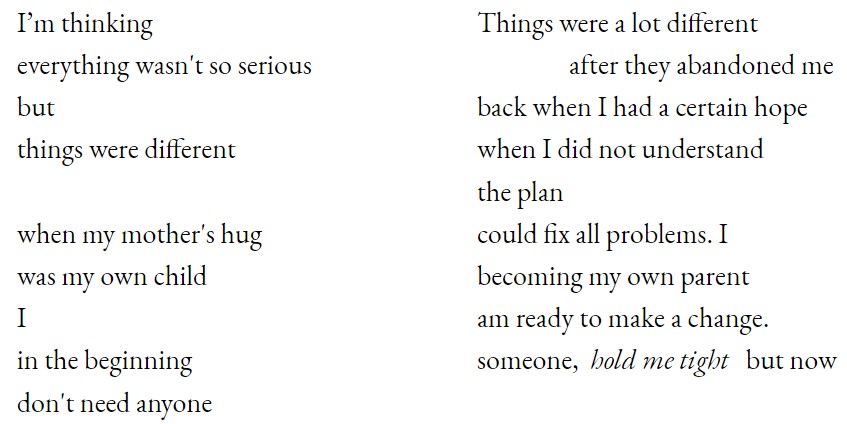
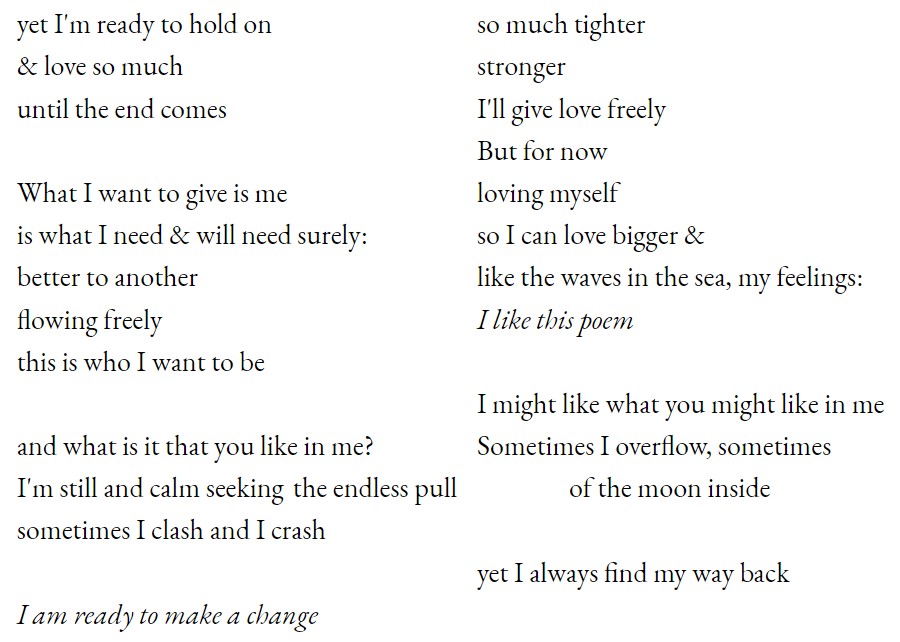
Trace Howard DePass is the author of self-portrait As the Space Between Us (PANK Books, 2018), which was a finalist for the 2019 Eric Hoffer Book Prize. He served as the editor of Scholastic’s Best Teen Writing of 2017 and as the 2016 Teen Poet Laureate for the Borough of Queens. His work has been featured on screen and radio—including BET Next Level, Billboard, Blavity, Poetry Foundation, Ours Poetica, and NPR’s The Takeaway—and in print in SAND Journal, Entropy Magazine, Sonora Review, Platypus Press, Split This Rock, The Poetry Project, Bettering American Poetry (Volume 3), and the Academy of American Poets Poem-a-Day series. DePass is a fellow with Poetry Foundation’s Teaching Artist Project and Poets House, and a Teachers & Writers Editorial Fellow.

